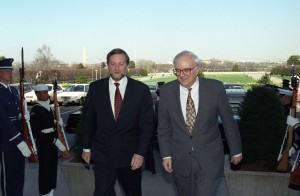This article is special to The Hunt for Strategic September, a week of analysis on the relevance of strategic guidance to today’s maritime strategy(ies).

Before our other writers suggest ways ahead for strategic guidance I thought I’d take a brief look at the origins and of the American institution of what has come to be the Quadrennial Defense Review (QDR).
Our first stop: 1993. The Soviet Union, “the threat that drove our defense decision-making,” had died in an aborted coup two years prior, at the barricades of the Russian White House. At the request of Congress, the U.S. Department of Defense conducted what it called the Bottom Up Review (BUR), an analysis of the nation’s strategic outlook, the forces required to meet the still-present dangers of the world and the thorough scrubbing of Department-wide processes to best support those capabilities. The BUR was developed to respond to a changed world, but one recognizable today, with such headlining concerns earlier outlined to the Atlantic Council by Les Aspin, Secretary of Defense at the time of the BUR, as terrorism, “regional thugs”, and Japanese economic power (so some things have actually changed).
One of the most important decisions made in the BUR was to choose as its force structure-requirement benchmark the ability to fight and win to major regional contingencies (MRCs). As a result, a critique leveled at the BUR was that while it paid lip service to other objective-driven force structure requirements – such as the naval need to furnish 11 carriers (plus a reserve training carrier) to sustain a global presence – it nonetheless rested on an assumption that the ability to prevail in two MRCs would provide enough force structure to handle all requirements from “lesser-included cases.” The fault in this assumption, the critique posited, was that it did not fully recognize the specific and perhaps different capabilities, nor the straining operational tempo, such lesser contingency or peacetime operations would demand from the active duty force.
Another guiding assumption in the BUR was the belief that even in a fiscally constrained environment the military could sustain its readiness without risking what it termed “force enhancement”. This was essentially a gamble that procurement, and research and development efforts to modernize the force could be sustained along with readiness, at the cost of some downsizing of the Armed Forces.
By 1997 the BUR’s 2 MRC requirement had been adopted by the National Security Strategy and National Military Strategy. However, Eric Larson notes that by this point it had also become clear that high deployment-rates and operational tempos were not only degrading readiness but were risking the vaunted force enhancements, as funds marked for modernization were shifted to operations and maintenance accounts whenever one of those ol’ lesser –case contingencies reared its head. Additionally, Larson wrote that “research in fact suggests that the cumulative level of peacetime operations approximated a full MRC or more of force structure.” Against this backdrop Congress would act (yes, there was a time those two words could appear together in the same sentence). With the 1997 National Defense Authorization Act Congress formally established the requirement for a “comprehensive examination” every four years, specifically entitled the Quadrennial Defense Review, tasking the Secretary of Defense to examine:
─ Force structure
─ Force modernization plans
─ Infrastructure
─ Budget plan
─ Other elements of the defense program and policies of the United States
How did the first QDR play out? Stay tuned…
LT Scott Cheney-Peters is a surface warfare officer in the U.S. Navy Reserve and the former editor of Surface Warfare magazine. He is the founding director of the Center for International Maritime Security and holds a master’s degree in National Security and Strategic Studies from the U.S. Naval War College.
